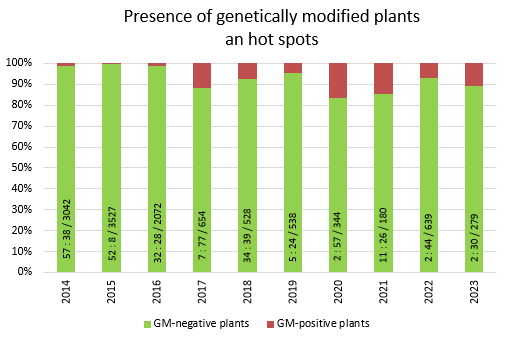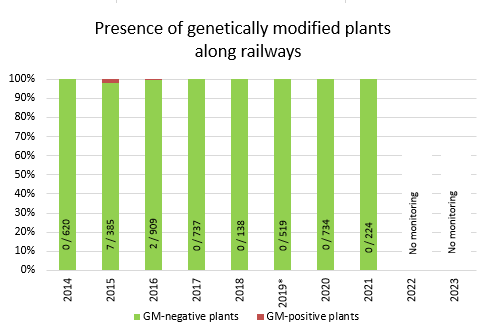Presence of genetically modified rapeseed in the environment
In Switzerland there is a moratorium banning the release of genetically modified organisms (GMOs) into the environment for other than scientific purposes. However, agricultural exporting countries such as the US and Canada are already cultivating GMOs on a large scale. As a result, genetically modified plants can end up contaminating goods that are imported into Switzerland and eventually enter the environment. This risk must be contained as far as possible in order to prevent the contamination of conventional agricultural crops and any damage to biodiversity.
 impossible to evaluate
impossible to evaluate
 impossible to evaluate
impossible to evaluate


Environmental monitoring results show that the percentage of plants that test positively is low, although the possibility that genetically modified rapeseed plants could accidentally end up in the environment cannot be entirely ruled out. One major reason for the presence of genetically modified organisms in the environment is that contaminated agricultural products are imported from countries where genetically modified plants are grown. The cantons apply control measures against genetically modified plants wherever positive test results are found and, in doing so, continue to ensure that no new and lasting populations of plants can be created by genetically modified seeds present in the soil.
This indicator is not assessed. The data primarily depend on external factors such as GMO-contaminated agricultural products imported into Switzerland, the number of hotspots and type of hotspot.
In order to detect any adverse effects caused by the presence of genetically modified organisms (GMOs) in the environment at an early stage, the FOEN has developed a monitoring system for GM oilseed rape at hotspots and along railway lines. Hotspots are places where GM oilseed rape is more likely to be found (e.g. freight transfer points such as marshalling yards, freight yards and transport hubs, food and feedstuff companies, bird feeding areas). Each year, a risk-based assessment is made of the number of hotspots and the type of hotspot at which GMOs should be searched for. The number of hotspots and their type can therefore vary from year to year.
In addition to hotspot monitoring, the FOEN has established a monitoring system for GM oilseed rape along the SBB rail network. From 2014 to 2019, the FOEN carried out random monitoring along the tracks (30 rail sections each 1km long). In 2020, a new sampling approach with a weighted random sample was introduced, and this increased the detection of rape along the tracks by 20 per cent.
Since 2022, however, monitoring along tracks has no longer been carried out annually. The risk of GMOs entering the environment along tracks is currently considered negligible, there having been far fewer rape finds in recent years, despite optimisation of the approach. One explanation for this is that the SBB has altered its efforts to control the growth of undesirable plants in the area of the tracks in recent years, and has also replaced track ballast (in which rape grows) on a large scale.
Further information






